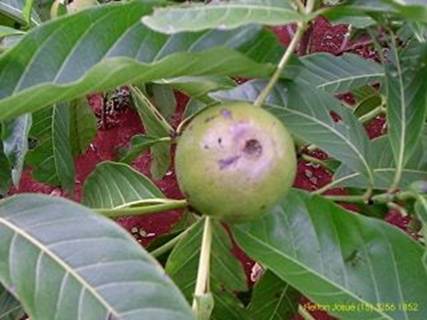ALIBERTIA EDULIS
POPULAR NAME: PURUÍ, MARMELADA, GOIABA PRETA.
RUBIACEAE

INDIGENOUS NAME: Puruí comes from the Tupi-Guarani and means "sweet and sour fruit" because it points out the strong taste of the sweet quince with a very pleasant sweet.
Origin: Savannas throughout Brazil.
Characteristcs: Small with conical crown of the height of up to 4 m (13 feet), the crown is narrow of up to 3 meters (10 feet) of width at the base and 50 cm (2 feet) at the apex. The trunk is quadratic ripped and black colored. Dioecious plant, with masculine and feminine individuals in separate plants. The plants cannot differentiate before they blossom. The feminine flowers are large and solitary, the male is small and clustered.
Planted in the site of Frutas Raras: October 2001, flowered in 2003 for the first time, bear fruit in 2004 for the first time.
Tips for cultivation: Fast-growing shrub, appreciates red and argillaceous ground with fast draining of the rain water and around 5.5 pH. It does resist light frosts of up to 0°C (32°F), will resist more to -3°C (27°F) degrees if grown under trees resistant to other, less fruit because of the shade.
Propagation:
Seeds are kept in the refrigerator for up to 1 year, germinate in
Planting: I recommend to plant in full sun in the space of 5 x 5 m (17 x 17 feet). Best planting season is November to January, water after planting and every 15 days if no rain.
Cultivating: The
plant grows fast and needs no special care, only the holes should be deep,
because the plant has a taproot.
Make pruning to form.
Fertilize with organic compost, can be (
Uses: The fruit is consumed in-kind, ice cream is a delicious dessert, in the form of jam, juices and ice creams.
Flowering time in the site of Frutas Raras: October to February.
Fruiting time in the site of Frutas Raras: September to March.
BUY THE BOOK “COLECIONANDO FRUTAS”
Back to the seedlist (English) or back to Rubiaceae (Portuguese)